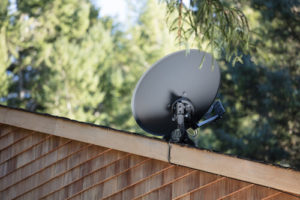Of course, there’s more to it than that—you may even want to check for alternative internet options if your satellite internet service makes you want to flip your desk. But hey, before you turn that desk’s world upside down, check out our tips on how to make sure your satellite receiver is in good shape, how to get your modem and router in working order, and how to get the most out of a satellite internet Wi-Fi connection. Let’s get to it! So, if you want to speed up your satellite internet connection, we recommend checking for alternative providers. Now, hold on a second before you get upset. We know you’re probably using satellite because it’s the only choice you have. But it never hurts to check and see if another company has added a line out to your home since you last looked. Our ZIP Finder can give you a head start here. Just enter your ZIP code to see what internet service providers (ISPs) are in your area. Take a peek at our Viasat review and our HughesNet review to get a clear look at how these two satellite providers handle download speeds, data caps, and more. Lastly, we want to leave you on a hopeful note. While you’re stuck with only two satellite internet options right now, there is a light at the end of the tunnel. SpaceX’s Starlink satellite internet is rolling out services across the US and Canada. Starlink Internet will hopefully offer higher speeds and low latency internet from almost anywhere. This is great news for remote workers, travelers and those in more rural areas. More choices are always a good thing. First off, let’s take a look at your satellite receiver, or dish. You want to look for any cracks, chips, or other damage to your dish and cables. You’ll also want to make sure your cables aren’t loose where they connect to your dish. And make sure no squirrels or other hungry animals have nibbled on them. If you think your dish isn’t properly positioned, we recommend calling your satellite internet provider and asking them to reposition it. The reason you should have a tech come out to do this is because your ISP will know exactly how to configure your dish’s orientation so it matches the coordinates that will get you the best signal. (Those coordinates are specific to your house and location.) It’s time to take a look at your modem and router to see if you can optimize your internet equipment to get better internet speeds. P.S. We cover some of these tips in our guide on how to get faster internet too. If you can, we always recommend using your own router so you can make sure it’s not only up to date, but that it also includes the features that you want, like multiple Ethernet ports, dual-band technology, and maybe even beamforming, if you’re feeling fancy. Not to keep beating that poor, dead horse, but there might be something to this advice. Power cycling, or restarting your modem and router, can reset a troublesome connection. Here’s how to restart your modem and router: Think of your router’s firmware like a pro athlete eating a highly nutritious meal before a big game. They need that energy to perform well and make the winning pass. You can find the latest firmware for your router on the manufacturer’s site. Here are some of the more popular brands that let you search for your router’s firmware using its model number or name:
NETGEAR TP-Link ASUS Linksys Synology
Why is that? Well, because Wi-Fi travels through the air instead of through a cable, your internet connection loses speed and signal strength as it travels over distance and has to go through walls, floors, and other objects. A wired connection, on the other hand, just has to travel through the Ethernet cable to get to your device. If you must use Wi-Fi, you can try swapping to a different frequency if you have a dual-band router. If you’re currently on your router’s 2.4 GHz frequency network, try swapping to the 5 GHz frequency network. This is one of the best Wi-Fi boosters for satellite internet. Your internet might kick into a higher gear if the frequency you swap to is being used by fewer devices that are all demanding that sweet high-speed connection. Keeping your router close means your internet connection has less distance to travel to reach your devices. And less distance means a stronger signal—which is great for your The Last of Us binge-watching session on HBO Max. The difference was shocking. Before the Wi-Fi extender, my signal would drop out in the bedroom constantly. I couldn’t fall asleep to episodes of The Office. Yup, I had to stand on the bed and yell, “I declare internet bankruptcy!” (Office fans will get that one.) After plugging in the Wi-Fi extender and getting it set up on the network, which took about five minutes, I got a strong, reliable signal in the guest bedroom. Yasss! A mesh system sort of blankets your house with a Wi-Fi signal by using points in different rooms. The points act kind of like Wi-Fi extenders, but (depending on the mesh system you get) they may also have an Ethernet port that allows your son to play Call of Duty on the computer in his room while your daughter plays Fortnite on the Xbox downstairs. P.S. If you’re looking at mesh Wi-Fi systems, check out our Google Nest Wi-Fi review to see if it’s a match for your internet needs.
